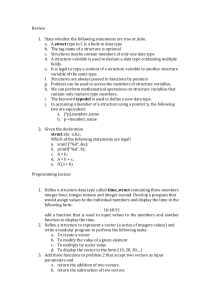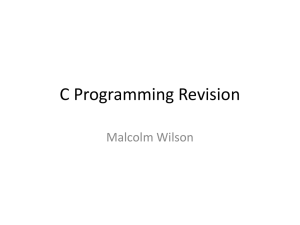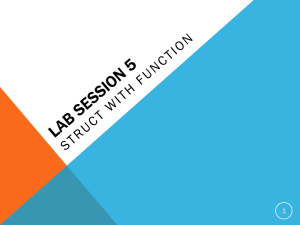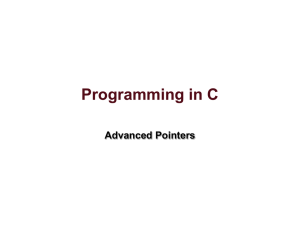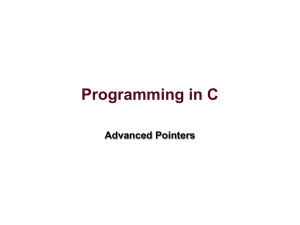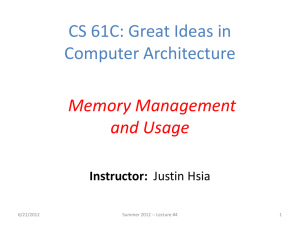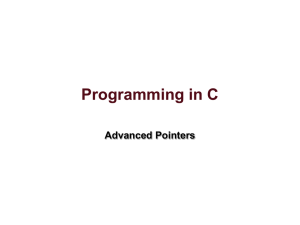Lecture 21
advertisement
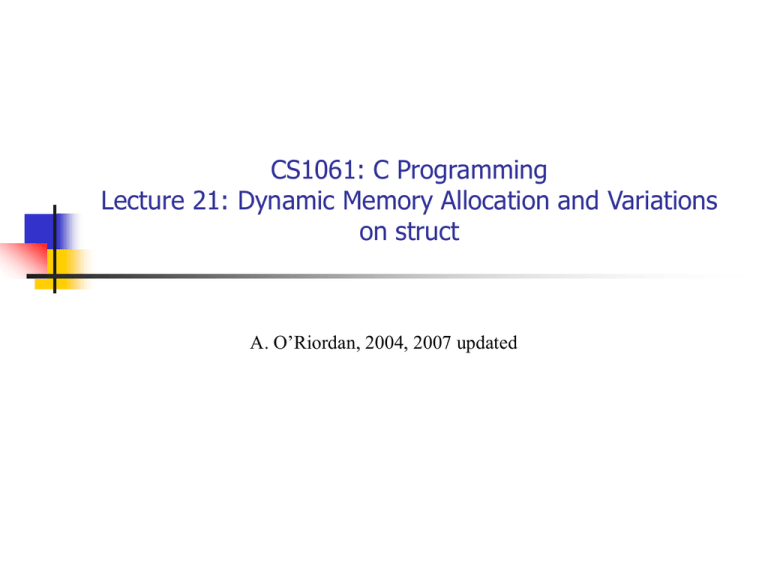
CS1061: C Programming
Lecture 21: Dynamic Memory Allocation and Variations
on struct
A. O’Riordan, 2004, 2007 updated
Dynamic Memory Allocation
Dynamic memory allocation is used to obtain and release memory during program
execution. Up until this point we reserved memory at compile time using
declarations.
You have to be careful with dynamic memory allocation. It operates at a low-level,
you will often find yourself having to do a certain amount of work to manage
the memory it gives you.
To use the functions discussed here, you must include the stdlib.h header file.
Four Dynamic Memory Allocation Functions:
Allocate memory - malloc(), calloc(), and realloc()
Free memory - free()
malloc()
To allocate memory use
void *malloc(size_t size);
Takes number of bytes to allocate as argument.
Use sizeof to determine the size of a type.
Returns pointer of type void *. A void pointer may be assigned to any pointer.
If no memory available, returns NULL.
e.g.
char *line;
int linelength = 100;
line = (char*)malloc(linelength);
malloc() example
To allocate space for 100 integers:
int *ip;
if ((ip = (int*)malloc(100 * sizeof(int))) == NULL){
printf("out of memory\n");
exit();
}
Note we cast the return value to int*.
Note we also check if the function returns NULL.
Allocating memory for a struct
You can also allocate memory for a struct.
Example:
struct node *newPtr;
newPtr = (struct node *)malloc(sizeof(struct node));
Memory allocated with malloc() lasts as long as you want it to.
It does not automatically disappear when a function returns, as automatic-duration
variables do, but it does not have to remain for the entire duration of your
program, either. There is a mechanism to free allocated memory.
free()
To release allocated memory use
free()
Deallocates memory allocated by malloc().
Takes a pointer as an argument.
e.g.
free(newPtr);
Freeing unused memory is a good idea, but it's not mandatory. When your
program exits, any memory which it has allocated but not freed will be
automatically released.
calloc()
Similar to malloc(), the main difference is that the values stored in the allocated
memory space are zero by default. With malloc(), the allocated memory could
have any value.
calloc() requires two arguments - the number of variables you'd like to allocate
memory for and the size of each variable.
void *calloc(size_t nitem, size_t size);
Like malloc(), calloc() will return a void pointer if the memory allocation was
successful, else it'll return a NULL pointer.
calloc() example
/* Using calloc() to initialize 100 floats to 0.0 */
#include <stdlib.h>
#include <stdio.h>
#define BUFFER_SIZE 100
int main(){
float * buffer;
int i;
if ((buffer = (float*)calloc(BUFFER_SIZE, sizeof(float))) == NULL){
printf("out of memory\n");
exit(1);
}
for (i=0; i < BUFFER_SIZE; i++)
printf(“buffer[%d] = %f\n”, i, buffer[i]);
return 0;
}
realloc()
If you find you did not allocate enough space use realloc().
You give realloc() a pointer (such as you received from an initial call to malloc())
and a new size, and realloc does what it can to give you a block of memory big
enough to hold the new size.
int *ip;
ip = (int*)malloc(100 * sizeof(int));
...
/* need twice as much space */
ip = (int*)realloc(ip, 200 * sizeof(int));
Variations on struct: union and bit field
Union
can hold data of different types
sharing the same starting address
New keyword union
Bit Field
Up to now the smallest unit we worked with was a char (1 byte) but with the
struct keyword you can declare and use smaller objects which allows you to
declare and use a single bit.
There is no new keyword
union data type (1)
This is a special data type which looks similar to a struct used for low-level
programming (e.g hardware devices).
Memory that contains a variety of objects over time.
Only contains one data member at a time.
Members of a union share space.
Conserves storage.
union Number {
int x;
float y;
};
union Number value;
union data type (2)
Single memory address used to store the largest variable, unlike the arrangement
used for structures.
Valid union operations (same as for structs)
Assignment to union of same type: =
Taking address: &
Accessing union members: .
Accessing members using pointers: ->
Bit fields in struct
Member of a structure whose size (in bits) has been specified.
Enable better memory utilization .
Must be declared as int or unsigned.
Declaring bit fields -follow unsigned or int member with a colon (:) and an
integer constant representing the width of the field.
Example:
struct PlayingCard{
unsigned face:4;
unsigned suit:2;
unsigned color:1;
};

